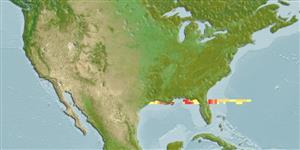Environment: milieu / climate zone / depth range / distribution range
Ecology
Marine; pelagic-oceanic; depth range ? - 403 m (Ref. 58018). Tropical; 30°N - 29°N, 87°W - 89°W (Ref. 57476)
Western Atlantic: southern Florida and northern Gulf of Mexico in USA, possibly to Brazil.
Size / Weight / Age
Maturity: Lm ? range ? - ? cm
Max length : 60.0 cm TL male/unsexed; (Ref. 7251)
Oviparous, eggs are pelagic (Ref. 205).
Life cycle and mating behavior
Maturities | Reproduction | Spawnings | Egg(s) | Fecundities | Larvae
Robins, C.R. and G.C. Ray, 1986. A field guide to Atlantic coast fishes of North America. Houghton Mifflin Company, Boston, U.S.A. 354 p. (Ref. 7251)
IUCN Red List Status (Ref. 130435)
Threat to humans
Harmless
Human uses
Fisheries: minor commercial
Tools
Special reports
Download XML
Internet sources
Estimates based on models
Preferred temperature (Ref.
123201): 18 - 25.6, mean 24 °C (based on 46 cells).
Phylogenetic diversity index (Ref.
82804): PD
50 = 0.5156 [Uniqueness, from 0.5 = low to 2.0 = high].
Bayesian length-weight: a=0.01380 (0.00555 - 0.03435), b=3.06 (2.85 - 3.27), in cm total length, based on LWR estimates for this (Sub)family-body shape (Ref.
93245).
Trophic level (Ref.
69278): 3.8 ±0.6 se; based on size and trophs of closest relatives
Resilience (Ref.
120179): Medium, minimum population doubling time 1.4 - 4.4 years (Preliminary K or Fecundity.).
Fishing Vulnerability (Ref.
59153): Moderate vulnerability (44 of 100).
Climate Vulnerability (Ref.
125649): High to very high vulnerability (69 of 100).
Nutrients (Ref.
124155): Calcium = 85 [43, 201] mg/100g; Iron = 1.2 [0.7, 2.2] mg/100g; Protein = 18.5 [15.9, 20.9] %; Omega3 = 0.205 [0.114, 0.367] g/100g; Selenium = 70.2 [30.9, 149.7] μg/100g; VitaminA = 18.1 [4.9, 70.6] μg/100g; Zinc = 0.91 [0.59, 1.38] mg/100g (wet weight);
